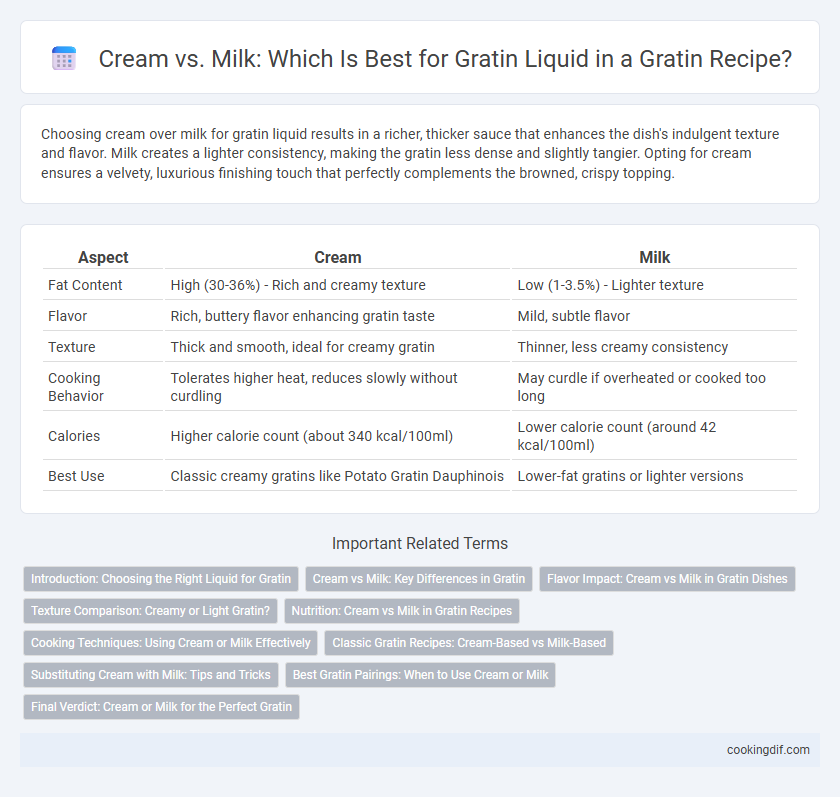Choosing cream over milk for gratin liquid results in a richer, thicker sauce that enhances the dish's indulgent texture and flavor. Milk creates a lighter consistency, making the gratin less dense and slightly tangier. Opting for cream ensures a velvety, luxurious finishing touch that perfectly complements the browned, crispy topping.
Table of Comparison
| Aspect | Cream | Milk |
|---|---|---|
| Fat Content | High (30-36%) - Rich and creamy texture | Low (1-3.5%) - Lighter texture |
| Flavor | Rich, buttery flavor enhancing gratin taste | Mild, subtle flavor |
| Texture | Thick and smooth, ideal for creamy gratin | Thinner, less creamy consistency |
| Cooking Behavior | Tolerates higher heat, reduces slowly without curdling | May curdle if overheated or cooked too long |
| Calories | Higher calorie count (about 340 kcal/100ml) | Lower calorie count (around 42 kcal/100ml) |
| Best Use | Classic creamy gratins like Potato Gratin Dauphinois | Lower-fat gratins or lighter versions |
Introduction: Choosing the Right Liquid for Gratin
Cream provides a rich, velvety texture and enhances the gratin's golden, bubbling crust with its higher fat content, creating a luscious mouthfeel. Milk, being lighter, offers a more delicate consistency that allows the natural flavors of the ingredients to shine without overwhelming richness. Selecting between cream and milk depends on the desired balance between indulgence and subtlety in gratin dishes, influencing both taste and texture outcomes.
Cream vs Milk: Key Differences in Gratin
Cream delivers a richer, silkier texture and deeper flavor to gratin due to its higher fat content, enhancing browning and a luscious mouthfeel. Milk, with lower fat and more water, creates a lighter, less indulgent gratin but may result in a thinner sauce and less pronounced caramelization. Chefs often choose cream for decadent dishes, while milk suits lighter gratins where subtlety and lower calories are desired.
Flavor Impact: Cream vs Milk in Gratin Dishes
Using cream in gratin dishes delivers a rich, velvety texture and a deeper, more indulgent flavor due to its higher fat content, which enhances the overall mouthfeel and caramelization during baking. Milk provides a lighter, more subtle creaminess that allows other ingredients like cheese and herbs to shine without overwhelming the palate. The choice between cream and milk significantly influences the gratin's flavor profile and richness, with cream offering decadent depth and milk contributing a delicate balance.
Texture Comparison: Creamy or Light Gratin?
Using cream for gratin results in a rich, velvety texture that enhances the dish with luxurious creaminess and a thicker consistency. Milk produces a lighter, more delicate gratin with a smoother mouthfeel, allowing other ingredients' flavors to shine without overpowering richness. Choosing cream emphasizes indulgence and depth, whereas milk offers a balanced, subtly creamy finish.
Nutrition: Cream vs Milk in Gratin Recipes
Using cream in gratin recipes significantly increases the calorie and fat content, providing a rich source of saturated fats and fat-soluble vitamins like A and D. Milk offers a lighter alternative, delivering essential nutrients such as calcium and protein with fewer calories and less fat. Choosing between cream and milk affects not only the texture and flavor but also the nutritional profile, making milk preferable for a lower-fat option and cream for a more indulgent dish.
Cooking Techniques: Using Cream or Milk Effectively
Using cream in gratin ensures a rich, velvety texture due to its higher fat content, which contributes to a more indulgent and golden crust when baked. Milk offers a lighter alternative, allowing the natural flavors of the ingredients to shine while producing a less dense sauce that remains moist and tender. Mastering heat control prevents curdling or separation, and combining cream and milk can balance richness with fluidity for optimal gratin consistency.
Classic Gratin Recipes: Cream-Based vs Milk-Based
Classic gratin recipes often call for cream to achieve a rich, velvety texture and a golden, bubbling top due to its higher fat content, which enhances flavor and browning. Milk-based gratins produce a lighter, less dense dish with a subtler taste, making them suitable for those seeking a lower-fat alternative while still maintaining moisture. The choice between cream and milk significantly influences the gratin's mouthfeel and intensity, with cream providing a luxurious, indulgent experience and milk lending a delicate, balanced result.
Substituting Cream with Milk: Tips and Tricks
Substituting cream with milk in gratin requires balancing richness and texture by using whole milk or adding butter to increase fat content for a creamier consistency. Thicken the mixture with a roux or cornstarch to mimic the luxurious mouthfeel cream provides while preventing the gratin from becoming watery. Incorporate cheese and seasonings strategically to enhance flavor and ensure the gratin remains indulgently smooth despite the lower fat substitution.
Best Gratin Pairings: When to Use Cream or Milk
For gratin dishes, cream delivers a rich, velvety texture and enhances the flavor with its higher fat content, making it ideal for decadent recipes such as potato or seafood gratins. Milk offers a lighter, less dense consistency that allows the natural flavors of vegetables or lean proteins like chicken to shine without overwhelming the dish. Choosing between cream and milk depends on the desired richness and the role of the gratin's main ingredients in the overall flavor profile.
Final Verdict: Cream or Milk for the Perfect Gratin
Using cream for gratin ensures a rich, velvety texture and a luxurious mouthfeel, while milk produces a lighter, less decadent dish with a subtler flavor. The choice between cream and milk ultimately depends on the desired richness and calorie content, with cream providing a custard-like consistency that enhances browning and depth of flavor. For optimal balance, many chefs recommend a blend of heavy cream and whole milk to achieve creamy indulgence without overwhelming heaviness.
Cream vs Milk for gratin liquid Infographic

 cookingdif.com
cookingdif.com